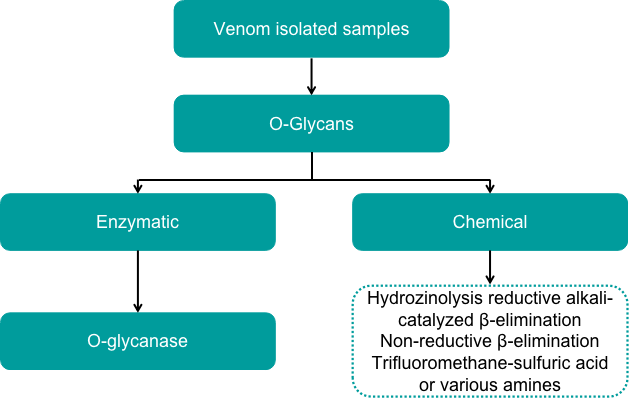Venom O-Glycan Analysis
Creative Proteomics has many years of experience in analysis services in the field of glycomics. In O-Glycan analysis services, it provides O-Glycan analysis services based on MALDI-TOF MS technology. According to your venom glycomics research purpose, a one-stop O-Glycan analysis techniques are used to meet your research needs. The venom O-Glycan analysis we provide is suitable for different types of poisonous species or venom research. Such as fire-bellied toads, snakes, scorpions, frogs, venomous lizard, snails, spiders, bees, ants, cone snails, jellyfish, etc.
Introduction to Venom O-Glycan Analysis

Glycosylation analysis is one of the most challenging post-translational modification analysis. Glycosylation modification is usually based on a group, rather than a single modification. Even a single glycosylation site on a protein may have different chain lengths and multiple glycan isomers connected to different branches. O-glycosylation (O-Glycan) is mainly connected to the polypeptide through the glycosidic bond between the terminal monosaccharide residue and the OH group of serine or threonine. The consensus sequence of the amino acids linked by the O-Glycan is not clear, and the structure of the O-Glycan is diverse and can be divided into several structural families with relatively heterogeneous core structures. Through the analysis of the venom O-Glycan, it is possible to mine the post-translational modification information of the venom protein, and provide a certain book basis for the analysis of the composition of the venom. In addition, it plays an important role in promoting the search for lead compounds in poisoning treatment and new drug design.
Technical Route
O-Glycan analysis is different from N-Glycan analysis. There is currently no universal enzyme that can digest most O-Glycan. O-Glycan can only enzymatically degrade glycans initiated by unsubstituted O-GalNAc disaccharides. Therefore, hydrolysis of O-Glycans by chemical methods is a more general method, and most of the O-Glycans can be released from O-Glycopeptides, that is, β-removal.
 Fig 1. The general process of sample preparation in O-Glycan analysis.
Fig 1. The general process of sample preparation in O-Glycan analysis.O-Glycan can be analyzed using MALDI-TOF MS. By analyzing the methylated O-Glycans after the derivatization reaction, all the hydroxyl groups are converted into methyl ether. And after stabilizing the sialic acid on the carboxyl group by methyl ester, the MALDI TOF MS can analyze O-Glycan in positive ion mode. Mass spectrometry analysis of methylated O-Glycans can obtain information about the composition of glycans.
Application Fields
- Identification and analysis of post-translational modification of venom protein O glycosylation.
- O-Glycanprofile analysis is a supplement to genomics and proteomics research.
- It can improve the understanding of the function of toxins and play an important role in promoting the search of lead compounds in poisoning treatment and new drug design.
How to Order?
Creative Proteomics has many years of experience in analysis services in the field of glycomics, and can tailor venom glycomics analysis services to your specific needs. Welcome to consult! You only need to place an order and send a venom sample, Creative Proteomics one-stop service is completed: sample processing, computer analysis, data analysis, and to project report. Thank you for your attention to our venom O-Glycan analysis service! If you have any questions, please fill in the inquiry form and contact us immediately.
For research use only. Not intended for any clinical use.


 Fig 1. The general process of sample preparation in O-Glycan analysis.
Fig 1. The general process of sample preparation in O-Glycan analysis.